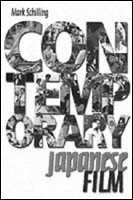Contemporary Japanese Film
by Jasper Sharp
Contemporary Japanese Film is a comprehensive and informative guide to a decade's worth of releases from Mark Schilling. Based in Japan since 1975, Schilling's name should be pretty well known to anyone with more than a passing interest in the subject, his writings having appeared in a host of publications ranging from the Asian Wall Street Journal to the Japanese edition of Premiere. However, he is best known for his regular contributions to the Japan Times, and this book is a collection of some 400 odd reviews dating from the period when he started writing for the publication in 1989.
Schilling's envious inside view perspective broadens the focus to cover the full spectrum of the nation's diverse output, highlighting to the rest of the world that the Japanese do not exist solely on a cinematic diet of wacky monster movies, solemn period dramas, gruesome horrors and violent yakuza actioners. Schilling's book admirably fills in the gaps between the small trickle of films that make it to overseas distribution out of the hundreds that are released domestically every year.
Where else are you going to read about Shikoku director Shunichi Nagasaki's romantic hospital drama Nurse Call (1993), or Kenki Segusa's botched attempt at remaking Rashomon for the MTV generation, Misty (1997)? Ever wondered how Shinji Aoyama cut his teeth in film-making prior to Eureka? Want to know what veterans such as Kei Kumai, Kon Ichikawa or Koji Wakamatsu have been up to in their twilight years? Well look no further. Dotted around you'll also see reviews of more familiar titles, such as Hideo Nakata's first two Ring films, the latest Godzilla and Gamera films, the entire Kitano oeuvre, and Akira Kurosawa's last gasps, Dreams (1990), Rhapsody in August (1991) and Madadayo (1993). As if this wasn't enough, a string of comprehensive essays and profiles fill the first hundred pages, giving the lowdown on the key developments in the industry during the decade's latest cinematic renaissance, articles on major players such as Akira Kurosawa, Juzo 'Tampopo' Itami and Shunji 'Swallowtail Butterfly' Iwai, as well as interviews with directors who deserve to be far better known to the rest of the world such as Jun Ichikawa and Makoto Shinozaki.
It's true, you may not get the opportunity to see a lot of these films, but I can guarantee if you look hard enough, you'll be surprised at home many of them show up in films festivals, English-subbed Asian DVD releases and embassy screenings. In any measure, Schilling's book at least lets you know what's out there as well as providing comprehensive cast lists, running times and both English and Japanese titles, and his in-depth reviews are written in an enlightening and entertaining enough manner to make for worthwhile reading in their own right, even if you don't agree with all of them.
Aside from a couple of minor quibbles (there a couple of typos, and a few more pages of photos wouldn't have gone amiss), the books only conceivable weakness is that it only covers the period from 1989-99, though this is hardly a criticism, because it does so in such a thorough manner that, either as a reference or introduction, Contemporary Japanese Cinema is a worthy addition to anyone's bookshelf.
